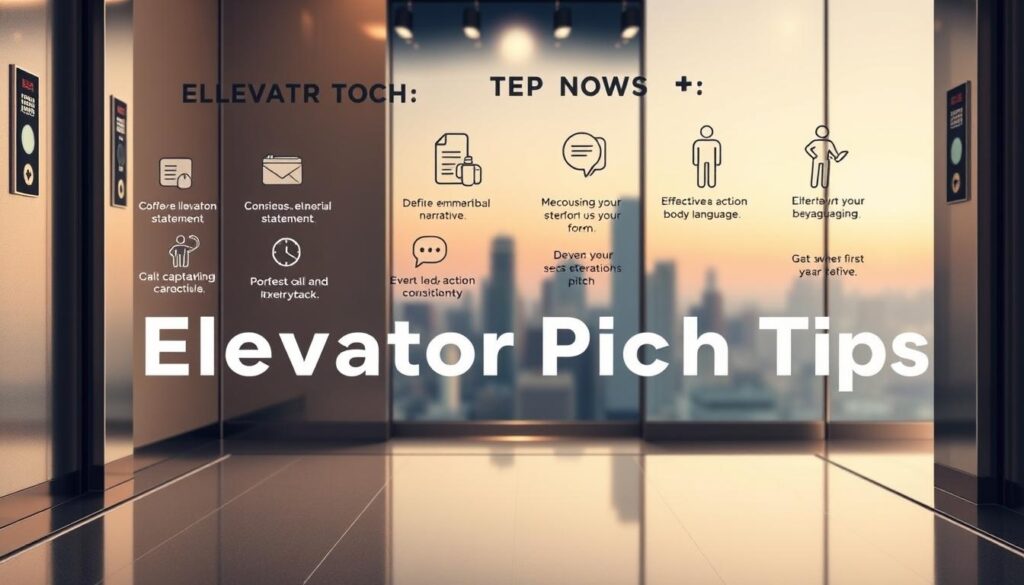Making a good elevator pitch is key to improving your professional life. It’s a short, powerful speech that introduces you, your business, or ideas in just a few minutes. It’s vital for networking and growing your business, opening doors to new chances and people.
This article will share top tips for a great elevator pitch. You’ll learn how to grab attention and leave a lasting impression. A good pitch boosts your confidence, makes you clearer in your communication, and prepares you for any situation. For more on making a pitch, check out this useful guide.
Table of Contents
Key Takeaways
- Understand the importance of a concise elevator pitch.
- Identify the key components for your pitch.
- Focus on your unique value proposition.
- Tailor your pitch for different audiences and situations.
- Practice consistently for a natural delivery.
Understanding the Importance of an Elevator Pitch
An elevator pitch is a key tool for improving your networking skills. It helps you make a lasting first impression in a short time. In today’s fast business world, knowing how to use an elevator pitch can set you apart.
This brief message can grab the attention of clients, partners, or employers. It’s a powerful way to start conversations that could lead to new opportunities.
The Role of an Elevator Pitch in Networking
Networking is all about quick, effective talks. An elevator pitch is vital for building professional connections. A good pitch showcases your strengths and makes you seem confident and friendly.
By sharing your value quickly, you spark curiosity. This curiosity can lead to deep, valuable conversations. Such talks can greatly expand your professional network.
How an Elevator Pitch Can Open Doors
One big advantage of an elevator pitch is it can open doors to new chances. It’s great for finding job interviews, investment opportunities, or partnerships. A strong pitch encourages others to talk more, increasing your success chances.
Elements of a Successful Elevator Pitch
A successful elevator pitch has key parts that make a big impact quickly. It aims to share your main points in 30 to 60 seconds. Here are the main elements to focus on for your pitch.
Key Components to Include in Your Pitch
Begin with an introduction that mentions your name and a quick summary of your career. Clearly state your role and what you offer. Highlight what makes you stand out in your field.
Make sure your pitch answers common questions about you and your interests. Tailor your message for your audience and situation. Use a friendly tone by asking questions or showing you’re willing to help. For more tips, check out this resource on crafting your elevator pitch.
Focusing on Your Unique Value Proposition
Your unique value proposition is the heart of a great elevator pitch. It shows what you bring to the table. Focus on the benefits you offer, like solving problems or saving time.
Your pitch should show off your personal brand and connect with your listeners. Telling a story about your value can make a strong impression. By focusing on these key points, you’ll be more likely to make a successful pitch that opens doors.
Creating an Elevator Pitch
Making a good elevator pitch means structuring your message well. A well-structured pitch shares your idea in a way that grabs attention. It also connects with your audience. Start strong to grab their interest right away.
Structuring Your Message for Impact
Use the “Problem-Solution” strategy to make a strong message. First, find a problem your audience knows. Then, show how your product or service solves it. Next, introduce yourself and what you offer.
What makes you different? Your unique selling point should be clear. End with a call-to-action to encourage your listener to learn more.
When crafting your pitch, keep it short and clear. Stay away from jargon that might confuse people. Use positive words and speak with enthusiasm. For more tips, check out this article on pitching your business plan.
Elevator Pitch Tips for Different Situations
It’s important to adjust your elevator pitch for different settings. Whether it’s a job interview or a networking event, you need a specific approach. Tailoring your pitch can help you leave a lasting impression.
Tailoring Your Pitch for Job Interviews
In job interviews, highlight your professional achievements. Show how your skills match the company’s needs. This can grab the interviewer’s attention and show you’re serious about joining.
Include specific examples to prove your qualifications. This link between your skills and the job shows you’re a good fit.
Adapting Your Pitch for Networking Events
Networking events are about building relationships, not just self-promotion. Use a friendly, conversational tone. Asking questions shows you’re interested in others.
When you share your background, add parts of your pitch that spark conversation. This approach encourages collaboration and can lead to new connections.
Crafting Your Elevator Pitch: Step-by-Step Guide
Starting to craft an elevator pitch means first understanding your audience. Knowing who you’re talking to helps you tailor your message. This makes it more likely to connect with them.
Do some research on the people you’ll meet. Think about how much they know about your area. This step is key to making your pitch interesting and relevant.
Writing your pitch involves several steps. Begin by jotting down key points that show what makes you special. Then, arrange these points in a way that makes sense.
Keep your first draft short and clear. Then, keep editing until your pitch is both brief and persuasive. This guide will help you create a pitch that meets your audience’s needs.
Elevator Pitch Examples for Inspiration
Learning from real-world scenarios can greatly enhance your ability to create an impactful elevator pitch. Seeing successful elevator pitches from different industries gives us valuable insights. It shows how effective messaging can grab an audience’s attention in a short time.
Think about entrepreneurs who got investment or professionals who found big roles with their pitches. Their stories teach us about the power of clear and concise messages.
Real-World Scenarios and Effective Deliveries
Real-world elevator pitch examples show the strength of clear and concise messages. For example, a tech start-up founder might quickly explain their app. They highlight how it solves a problem and its unique features.
On the other hand, a job-seeker might show their background and achievements at a networking event. This leaves a lasting impression on employers.
Learning from Successful Elevator Pitches
Studying successful elevator pitches reveals key elements that connect with audiences. Clarity, enthusiasm, and relevance are essential for delivering your message well. When you break down these pitches, look for common traits.
These include creating an emotional connection and telling a compelling story. These insights can inspire you to improve your own pitch. Make sure it meets your goals and engages your audience.
Elevator Pitch Template: Create Your Own
Creating an effective elevator pitch can be tough. A good template can help you make a pitch that really connects. It breaks down the process into easy steps.
Using a Template to Simplify the Process
Begin with the basics of your pitch. Think about these key points:
- Who you are: Briefly introduce yourself and your role.
- The problem you solve: Clearly state the issue at hand that you can address.
- Your unique value proposition: Highlight what sets you apart from others in your field.
- A call to action: Invite the listener to connect further or take specific action.
By focusing on these points, you can keep your pitch clear and focused. Make your template your own by adding your style and the audience’s needs. A friendly tone makes your pitch more engaging and effective.
Practising Your Elevator Speech
Practising your elevator speech is key to sounding confident and engaging. It helps you share your message clearly and connect with your audience. By rehearsing often, you can improve your tone, pace, and body language.
How to Rehearse for Natural Delivery
Use mirrors or record yourself to rehearse. This lets you see how you look and sound. Repeating your speech makes it feel more natural.
Try to keep it short, around 30 seconds. This keeps your message clear and to the point.
Receiving Feedback and Making Improvements
Getting feedback is vital for improving your pitch. Ask people you trust for their honest opinion. They can spot areas you might miss, like your tone or pace.
Use this feedback to keep improving. It boosts your confidence and makes your delivery better. Look at examples of great pitches at this link for inspiration.
Conclusion
Mastering the art of an effective elevator pitch is key to unlocking many professional doors. This article has shown its importance in communication and networking. Your pitch should highlight your unique value and be flexible for different situations.
It’s important to tailor your pitch for your audience. This ensures your message hits home. Practice and feedback are vital to improve your delivery. By following these tips, you can use your elevator pitch to boost your career or business.









